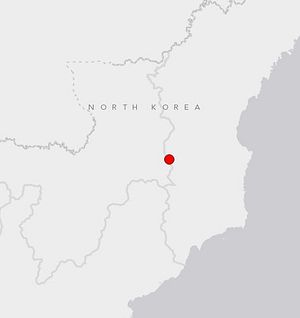At approximately 10:00 a.m. local time on Wednesday, January 6, North Korea detonated a nuclear device of an unknown yield. In an announcement on state television, the North Korean regime claimed that the device was a hydrogen bomb and that the test was successful. The test was conducted at 41.326°N 129.010°E, near the location of North Korea’s last test in February 2013, which was conducted at 41.302°N 129.066°E. Both test sites are a short distance from the North Korean nuclear facility at Punggye-ri. According to the European Mediterranean Seismological Center, the epicenter of the detonation was approximately 2 kilometers underground.
In announcing the test, the North Korean government emphasized that the device was to protect against powers hostile to the country. The timing of the attack is somewhat surprising as Kim Jong-un’s New Year’s address was less focused on the country’s military and the nuclear program than it was on economic issues. However, January 8 marks Kim’s birthday, suggesting that the nuclear test was something of a preemptive birthday celebration for the North Korean leader who took over after his father Kim Jong-il died in 2011. This is the second test on Kim Jong-un’s watch.
Independent verification of North Korea’s claims will take time, but initial impressions suggest that the device detonated was not a thermonuclear device, otherwise known as an H-bomb or hydrogen bomb. The measured seismic yield of the detonation was reported as 4.9 by China’s Earthquake Networks Center and as 5.1 by the U.S. Geological Survey. Both estimates suggest a yield similar to the device detonated in February 2013, which was the last nuclear test carried out by North Korea and involved a non-thermonuclear device.
I’d recommend reading Jeffrey Lewis’ recent article on the plausibility of North Korea having successfully developed a thermonuclear device. Lewis, commenting via Twitter, noted that the North Korean claims are likely exaggerated. At best, the device could have been boosted, but was “definitely not a successful staged device,” Lewis said.
Independent verification of the test by experts will be crucial. The United States is reportedly looking into Wednesday’s event. The U.S. Air Force has WC-135 Constant Phoenix aircraft stationed at Kadena Air Force Base in Okinawa, Japan that will likely conduct atmospheric analysis to detect radioactive material–this will help better ascertain the nature of the device that was detonated on Wednesday.
Additionally, the Comprehensive Test-Ban Treaty Organization will conduct its own analysis and provide an estimate of the device’s yield. According to James Acton, a nuclear expert and senior fellow at the Carnegie Endowment for International Peace, the seismic measurements from Wednesday’s test suggest that the yield of the device was in the range of 10 kilotons, similar to the February 2013 detonation.
































